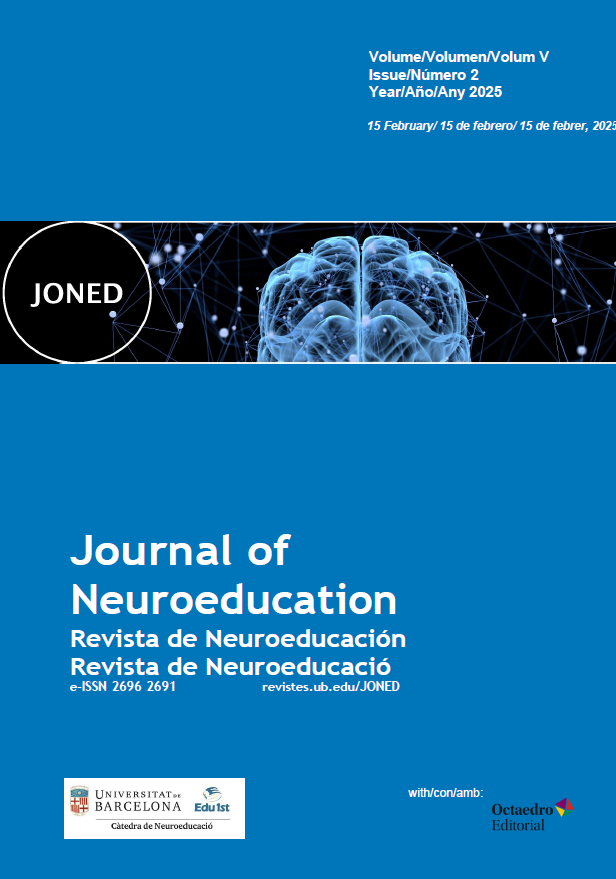Perspectives Of Brain Research (Educational Neuroscience) on the Design and Implementation of Teaching Strategies in Educational Technology
DOI:
https://doi.org/10.1344/joned.v5i2.47695Keywords:
Educational Neuroscience, Teaching Strategies, EdTechAbstract
The amalgamation of educational neuroscience and educational technology generates novel prospects for improving the understanding and efficacy of pedagogical approaches. By analyzing the brain's engagement with many educational technologies, educators can develop more effective instructional strategies customized to students' requirements. This approach can yield substantial enhancements in academic performance and offer varied and thorough learning experiences. This research investigates the influence of findings from educational neuroscience on the development and implementation of instructional strategies within educational technology. Analyze the amalgamation of educational technology with concepts from educational neuroscience and contrast conventional learning theories with those grounded on neuroscience. Present the empirical evidence supporting the improvement of learning outcomes through neuroscience-informed pedagogical approaches, as well as the challenges and constraints related to the application of educational neuroscience in educational technology.
References
Gkintoni, E., Dimakos, I., Halkiopoulos, C., & Antonopoulou, H. (2023). Contributions of neuroscience to educational praxis: A systematic review. Emerging Science Journal, 7, 146–158.
Tan, Y., & Amiel, J. (2019). Teachers learning to apply neuroscience to classroom instruction: Case of professional development in British Columbia. Professional Development in Education, 48(1), 70–87. https://doi.org/10.1080/19415257.2019.1689522
Bhargava, A., & Ramadas, V. (2022). Implications of neuroscience/neuroeducation in the field of education to enhance the learning outcomes of the students. Journal of Positive School Psychology, 6(6), 6502–6510.
Cearon, I., & Feltes, H. (2020). Neuroscience role in the foreign language teaching and learning. Ciência & Cognição, 25(1), 43–60.
Rosa-Salva, O., Mayer, U., Versace, E., Hébert, M., Lemaire, B. S., & Vallortigara, G. (2021). Sensitive periods for social development: Interactions between predisposed and learned mechanisms. Cognition, 213, 104552.
Nykyporets, S., Melnyk, O., Hadaichuk, N., Derun, V., & Chopliak, V. (2023). Neuropedagogical approach enhancing foreign language acquisition in non-linguistic higher education institutions. Актуальні питання у сучасній науці, 5, 341–355.
Fragkaki, M., Mystakidis, S., & Dimitropoulos, K. (2022). Higher education faculty perceptions and needs on neuroeducation in teaching and learning. Education Sciences, 12(10), 707.
Millei, Z., & Petersen, E. (2022). Psychology, psychiatry and neuroscience in education.
Marshall, L., & Bolt-Lee, C. (2022). A neuroeducation and cognitive learning-based strategy to develop active learning pedagogies for accounting education. Accounting Education Journal, 32.
Dubinsky, J. M., Roehrig, G., & Varma, S. (2013). Infusing neuroscience into teacher professional development. Educational Researcher, 42(6), 317–329. https://doi.org/10.3102/0013189X13499403
Britto, P. R., Yoshikawa, H., & Boller, K. (2011). Quality of early childhood development programs and policies in global contexts: Rationale for investment, conceptual framework and implications for equity. Social Policy Report, 25(2), 1–31.
Tominey, S. L., & McClelland, M. M. (2011). Red light, purple light: Findings from a randomized trial using circle time games to improve behavioral self-regulation in preschool. Early Education and Development, 22(3), 489–519. https://doi.org/10.1080/10409289.2011.574258
Diamond, A., & Lee, K. (2011). Interventions shown to aid executive function development in children 4 to 12 years old. Science, 333(6045), 959–964. https://doi.org/10.1126/science.1204529
Engle, P. L., Fernald, L. C. H., Alderman, H., Behrman, J., & O’Gara, C. (2011). Strategies for reducing inequalities and improving developmental outcomes for young children in low-income and middle-income countries. The Lancet, 378(9799), 1339–1353. https://doi.org/10.1016/S0140-6736(11)60889-1
Aboud, F. E., & Yousafzai, A. K. (2015). Global health and development in early childhood. Annual Review of Psychology, 66, 433–457. https://doi.org/10.1146/annurev-psych-010814-015128
Cowan, N. (2014). Working memory underpins cognitive development, learning, and education. Educational Psychology Review, 26(2), 197–223. https://doi.org/10.1007/s10648-013-9246-y
Sánchez-Sordo, J. M., & Teodoro-Vite, S. (2024). bRAin: Augmented reality brain model for teaching memory disorders to psychology students. Journal of Neuroeducation, 5(1). https://doi.org/10.1344/joned.v5i1.45812
Halkiopoulos, C., & Gkintoni, E. (2024). Leveraging AI in E-Learning: Personalized learning and adaptive assessment through cognitive neuropsychology. A systematic analysis. Electronics, 13(18), 3762. https://doi.org/10.3390/electronics13183762
Hattie, J., & Yates, G. (2014). Visible learning and the science of how we learn. Routledge.
Tyng, C. M., Amin, H. U., Saad, M. N. M., & Malik, A. S. (2017). The influences of emotion on learning and memory. Frontiers in Psychology, 8, 1454. https://doi.org/10.3389/fpsyg.2017.01454
Munakata, Y., Casey, B. J., & Diamond, A. (2004). Developmental cognitive neuroscience: Progress and potential. Trends in Cognitive Sciences, 8(3), 122–128. https://doi.org/10.1016/j.tics.2004.01.005
Kübler, A., & Zander, T. O. (2021). Brain-computer interfaces for neuroadaptive learning. Frontiers in Human Neuroscience, 15, 666642. https://doi.org/10.3389/fnhum.2021.666642
Holmes, W., Bialik, M., & Fadel, C. (2019). Artificial intelligence in education: Promises and implications for teaching and learning. Center for Curriculum Redesign.
Luckin, R., Holmes, W., Griffiths, M., & Forcier, L. B. (2016). Intelligence unleashed: An argument for AI in education. Pearson Education.
Downloads
Published
Issue
Section
License
Copyright (c) 2025 sani alkhassawneh, Houria Al Sharif

This work is licensed under a Creative Commons Attribution-NonCommercial 4.0 International License.
The authors who publish in this journal agree to the following terms:
a. Authors retain copyright and grant the journal the right of first publication
b. Texts will be published under a Creative Commons Attribution Non Commercial License that allows others to share the work, provided they include an acknowledgement of the work’s authorship, its initial publication in this journal and the terms of the license, and not for commercial use.



